Gender and Economic Determinants of HIV/AIDS in Sex Workers
VerifiedAdded on 2022/10/15
|9
|2101
|26
Essay
AI Summary
This essay examines the impact of gender and economic conditions on HIV/AIDS among sex workers in Thailand and Australia. It highlights that sex workers are at a higher risk of HIV/AIDS due to economic vulnerabilities. The prevalence of HIV/AIDS among Australian sex workers is lower compared to Thailand, where poverty and sex trafficking contribute to higher infection rates. Economic factors in both countries affect sex workers' ability to negotiate safe sex, but decriminalization programs in Australia offer better protection. Gender disparities, including violence and discrimination, further exacerbate the risk in Thailand. The essay recommends strategies such as pre-exposure prophylaxis, violence reduction, and decriminalization to mitigate the impact of social determinants of health on sex workers' vulnerability to HIV/AIDS. Desklib provides past papers and solved assignments for students.
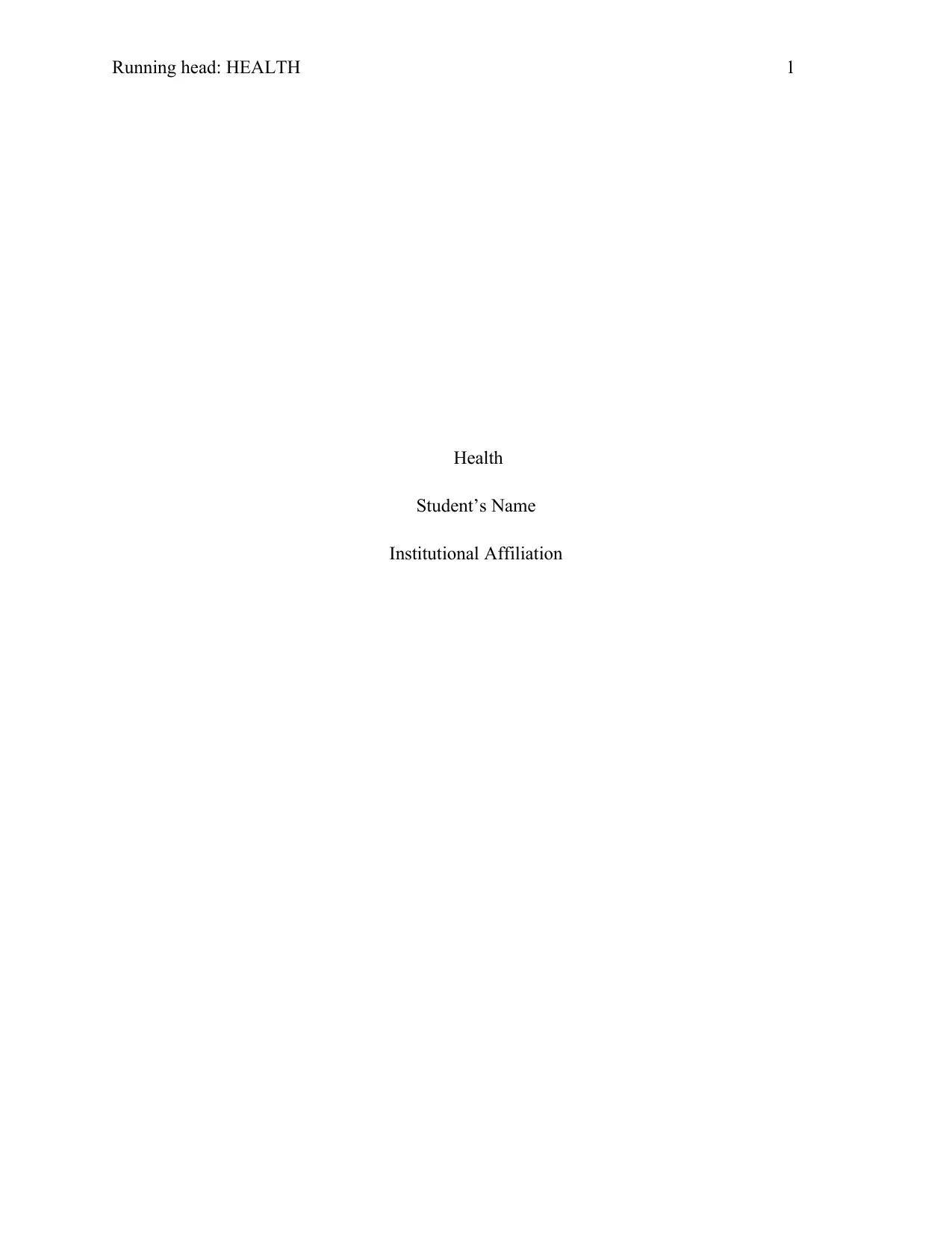
Running head: HEALTH 1
Health
Student’s Name
Institutional Affiliation
Health
Student’s Name
Institutional Affiliation
Paraphrase This Document
Need a fresh take? Get an instant paraphrase of this document with our AI Paraphraser
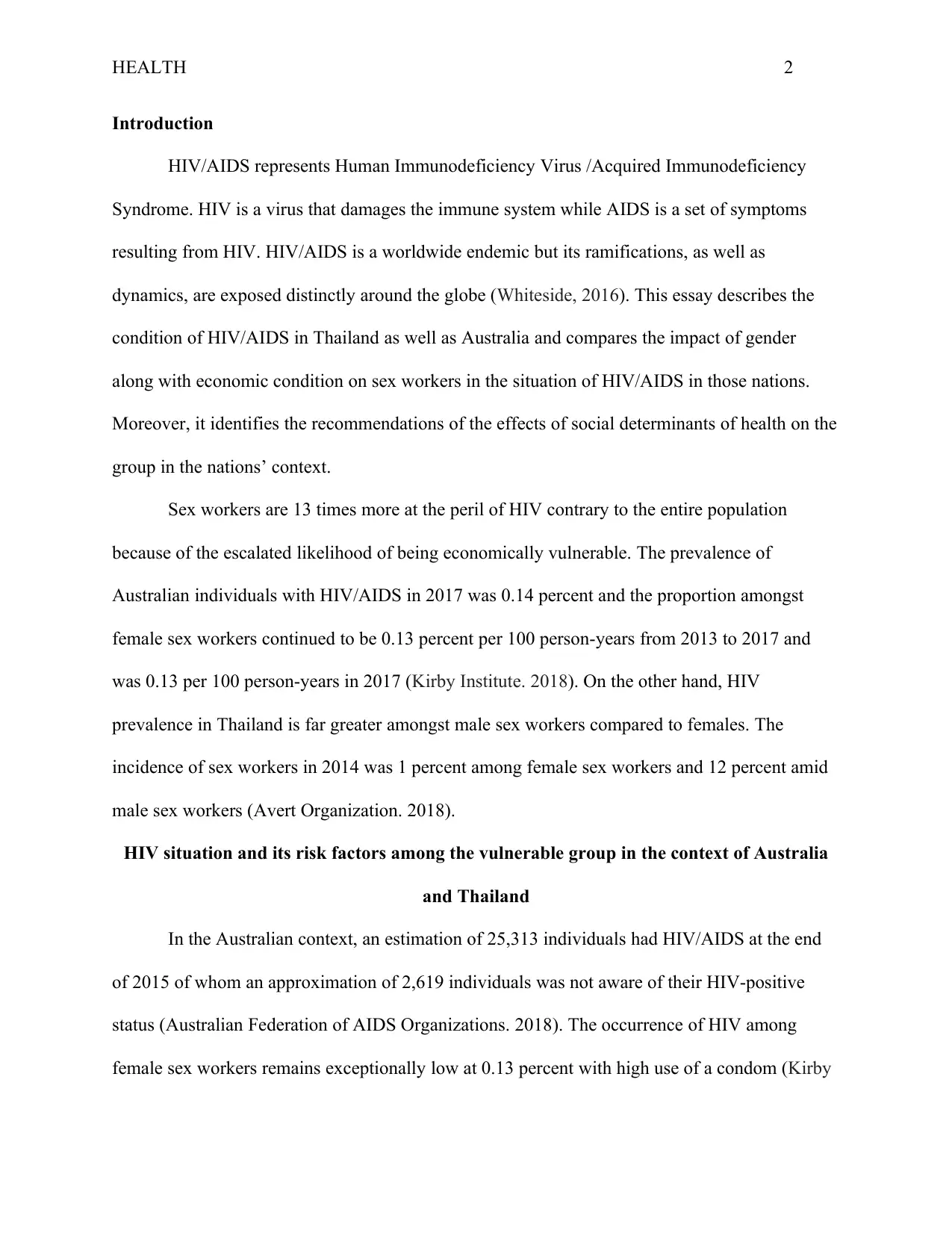
HEALTH 2
Introduction
HIV/AIDS represents Human Immunodeficiency Virus /Acquired Immunodeficiency
Syndrome. HIV is a virus that damages the immune system while AIDS is a set of symptoms
resulting from HIV. HIV/AIDS is a worldwide endemic but its ramifications, as well as
dynamics, are exposed distinctly around the globe (Whiteside, 2016). This essay describes the
condition of HIV/AIDS in Thailand as well as Australia and compares the impact of gender
along with economic condition on sex workers in the situation of HIV/AIDS in those nations.
Moreover, it identifies the recommendations of the effects of social determinants of health on the
group in the nations’ context.
Sex workers are 13 times more at the peril of HIV contrary to the entire population
because of the escalated likelihood of being economically vulnerable. The prevalence of
Australian individuals with HIV/AIDS in 2017 was 0.14 percent and the proportion amongst
female sex workers continued to be 0.13 percent per 100 person-years from 2013 to 2017 and
was 0.13 per 100 person-years in 2017 (Kirby Institute. 2018). On the other hand, HIV
prevalence in Thailand is far greater amongst male sex workers compared to females. The
incidence of sex workers in 2014 was 1 percent among female sex workers and 12 percent amid
male sex workers (Avert Organization. 2018).
HIV situation and its risk factors among the vulnerable group in the context of Australia
and Thailand
In the Australian context, an estimation of 25,313 individuals had HIV/AIDS at the end
of 2015 of whom an approximation of 2,619 individuals was not aware of their HIV-positive
status (Australian Federation of AIDS Organizations. 2018). The occurrence of HIV among
female sex workers remains exceptionally low at 0.13 percent with high use of a condom (Kirby
Introduction
HIV/AIDS represents Human Immunodeficiency Virus /Acquired Immunodeficiency
Syndrome. HIV is a virus that damages the immune system while AIDS is a set of symptoms
resulting from HIV. HIV/AIDS is a worldwide endemic but its ramifications, as well as
dynamics, are exposed distinctly around the globe (Whiteside, 2016). This essay describes the
condition of HIV/AIDS in Thailand as well as Australia and compares the impact of gender
along with economic condition on sex workers in the situation of HIV/AIDS in those nations.
Moreover, it identifies the recommendations of the effects of social determinants of health on the
group in the nations’ context.
Sex workers are 13 times more at the peril of HIV contrary to the entire population
because of the escalated likelihood of being economically vulnerable. The prevalence of
Australian individuals with HIV/AIDS in 2017 was 0.14 percent and the proportion amongst
female sex workers continued to be 0.13 percent per 100 person-years from 2013 to 2017 and
was 0.13 per 100 person-years in 2017 (Kirby Institute. 2018). On the other hand, HIV
prevalence in Thailand is far greater amongst male sex workers compared to females. The
incidence of sex workers in 2014 was 1 percent among female sex workers and 12 percent amid
male sex workers (Avert Organization. 2018).
HIV situation and its risk factors among the vulnerable group in the context of Australia
and Thailand
In the Australian context, an estimation of 25,313 individuals had HIV/AIDS at the end
of 2015 of whom an approximation of 2,619 individuals was not aware of their HIV-positive
status (Australian Federation of AIDS Organizations. 2018). The occurrence of HIV among
female sex workers remains exceptionally low at 0.13 percent with high use of a condom (Kirby
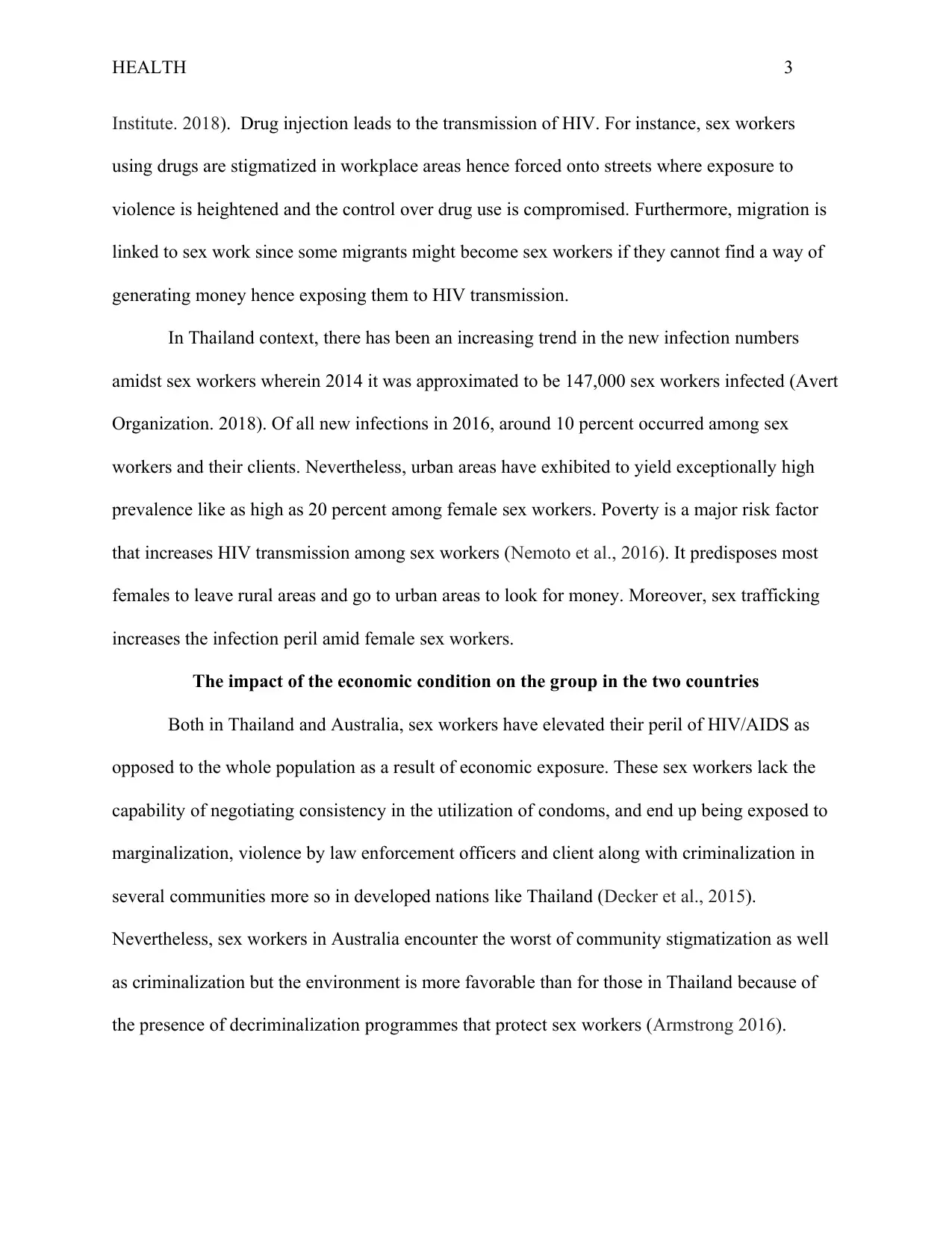
HEALTH 3
Institute. 2018). Drug injection leads to the transmission of HIV. For instance, sex workers
using drugs are stigmatized in workplace areas hence forced onto streets where exposure to
violence is heightened and the control over drug use is compromised. Furthermore, migration is
linked to sex work since some migrants might become sex workers if they cannot find a way of
generating money hence exposing them to HIV transmission.
In Thailand context, there has been an increasing trend in the new infection numbers
amidst sex workers wherein 2014 it was approximated to be 147,000 sex workers infected (Avert
Organization. 2018). Of all new infections in 2016, around 10 percent occurred among sex
workers and their clients. Nevertheless, urban areas have exhibited to yield exceptionally high
prevalence like as high as 20 percent among female sex workers. Poverty is a major risk factor
that increases HIV transmission among sex workers (Nemoto et al., 2016). It predisposes most
females to leave rural areas and go to urban areas to look for money. Moreover, sex trafficking
increases the infection peril amid female sex workers.
The impact of the economic condition on the group in the two countries
Both in Thailand and Australia, sex workers have elevated their peril of HIV/AIDS as
opposed to the whole population as a result of economic exposure. These sex workers lack the
capability of negotiating consistency in the utilization of condoms, and end up being exposed to
marginalization, violence by law enforcement officers and client along with criminalization in
several communities more so in developed nations like Thailand (Decker et al., 2015).
Nevertheless, sex workers in Australia encounter the worst of community stigmatization as well
as criminalization but the environment is more favorable than for those in Thailand because of
the presence of decriminalization programmes that protect sex workers (Armstrong 2016).
Institute. 2018). Drug injection leads to the transmission of HIV. For instance, sex workers
using drugs are stigmatized in workplace areas hence forced onto streets where exposure to
violence is heightened and the control over drug use is compromised. Furthermore, migration is
linked to sex work since some migrants might become sex workers if they cannot find a way of
generating money hence exposing them to HIV transmission.
In Thailand context, there has been an increasing trend in the new infection numbers
amidst sex workers wherein 2014 it was approximated to be 147,000 sex workers infected (Avert
Organization. 2018). Of all new infections in 2016, around 10 percent occurred among sex
workers and their clients. Nevertheless, urban areas have exhibited to yield exceptionally high
prevalence like as high as 20 percent among female sex workers. Poverty is a major risk factor
that increases HIV transmission among sex workers (Nemoto et al., 2016). It predisposes most
females to leave rural areas and go to urban areas to look for money. Moreover, sex trafficking
increases the infection peril amid female sex workers.
The impact of the economic condition on the group in the two countries
Both in Thailand and Australia, sex workers have elevated their peril of HIV/AIDS as
opposed to the whole population as a result of economic exposure. These sex workers lack the
capability of negotiating consistency in the utilization of condoms, and end up being exposed to
marginalization, violence by law enforcement officers and client along with criminalization in
several communities more so in developed nations like Thailand (Decker et al., 2015).
Nevertheless, sex workers in Australia encounter the worst of community stigmatization as well
as criminalization but the environment is more favorable than for those in Thailand because of
the presence of decriminalization programmes that protect sex workers (Armstrong 2016).
⊘ This is a preview!⊘
Do you want full access?
Subscribe today to unlock all pages.

Trusted by 1+ million students worldwide
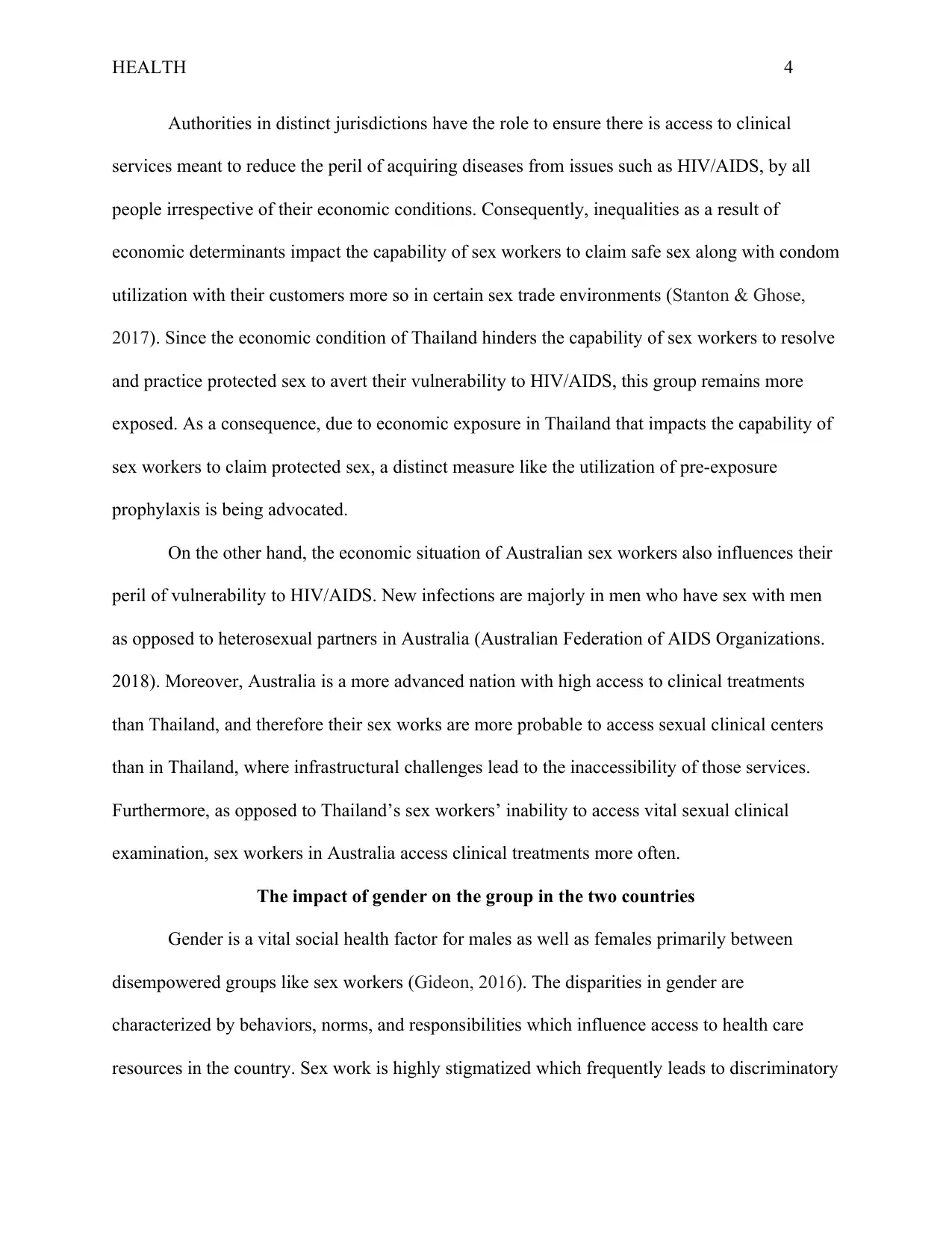
HEALTH 4
Authorities in distinct jurisdictions have the role to ensure there is access to clinical
services meant to reduce the peril of acquiring diseases from issues such as HIV/AIDS, by all
people irrespective of their economic conditions. Consequently, inequalities as a result of
economic determinants impact the capability of sex workers to claim safe sex along with condom
utilization with their customers more so in certain sex trade environments (Stanton & Ghose,
2017). Since the economic condition of Thailand hinders the capability of sex workers to resolve
and practice protected sex to avert their vulnerability to HIV/AIDS, this group remains more
exposed. As a consequence, due to economic exposure in Thailand that impacts the capability of
sex workers to claim protected sex, a distinct measure like the utilization of pre-exposure
prophylaxis is being advocated.
On the other hand, the economic situation of Australian sex workers also influences their
peril of vulnerability to HIV/AIDS. New infections are majorly in men who have sex with men
as opposed to heterosexual partners in Australia (Australian Federation of AIDS Organizations.
2018). Moreover, Australia is a more advanced nation with high access to clinical treatments
than Thailand, and therefore their sex works are more probable to access sexual clinical centers
than in Thailand, where infrastructural challenges lead to the inaccessibility of those services.
Furthermore, as opposed to Thailand’s sex workers’ inability to access vital sexual clinical
examination, sex workers in Australia access clinical treatments more often.
The impact of gender on the group in the two countries
Gender is a vital social health factor for males as well as females primarily between
disempowered groups like sex workers (Gideon, 2016). The disparities in gender are
characterized by behaviors, norms, and responsibilities which influence access to health care
resources in the country. Sex work is highly stigmatized which frequently leads to discriminatory
Authorities in distinct jurisdictions have the role to ensure there is access to clinical
services meant to reduce the peril of acquiring diseases from issues such as HIV/AIDS, by all
people irrespective of their economic conditions. Consequently, inequalities as a result of
economic determinants impact the capability of sex workers to claim safe sex along with condom
utilization with their customers more so in certain sex trade environments (Stanton & Ghose,
2017). Since the economic condition of Thailand hinders the capability of sex workers to resolve
and practice protected sex to avert their vulnerability to HIV/AIDS, this group remains more
exposed. As a consequence, due to economic exposure in Thailand that impacts the capability of
sex workers to claim protected sex, a distinct measure like the utilization of pre-exposure
prophylaxis is being advocated.
On the other hand, the economic situation of Australian sex workers also influences their
peril of vulnerability to HIV/AIDS. New infections are majorly in men who have sex with men
as opposed to heterosexual partners in Australia (Australian Federation of AIDS Organizations.
2018). Moreover, Australia is a more advanced nation with high access to clinical treatments
than Thailand, and therefore their sex works are more probable to access sexual clinical centers
than in Thailand, where infrastructural challenges lead to the inaccessibility of those services.
Furthermore, as opposed to Thailand’s sex workers’ inability to access vital sexual clinical
examination, sex workers in Australia access clinical treatments more often.
The impact of gender on the group in the two countries
Gender is a vital social health factor for males as well as females primarily between
disempowered groups like sex workers (Gideon, 2016). The disparities in gender are
characterized by behaviors, norms, and responsibilities which influence access to health care
resources in the country. Sex work is highly stigmatized which frequently leads to discriminatory
Paraphrase This Document
Need a fresh take? Get an instant paraphrase of this document with our AI Paraphraser
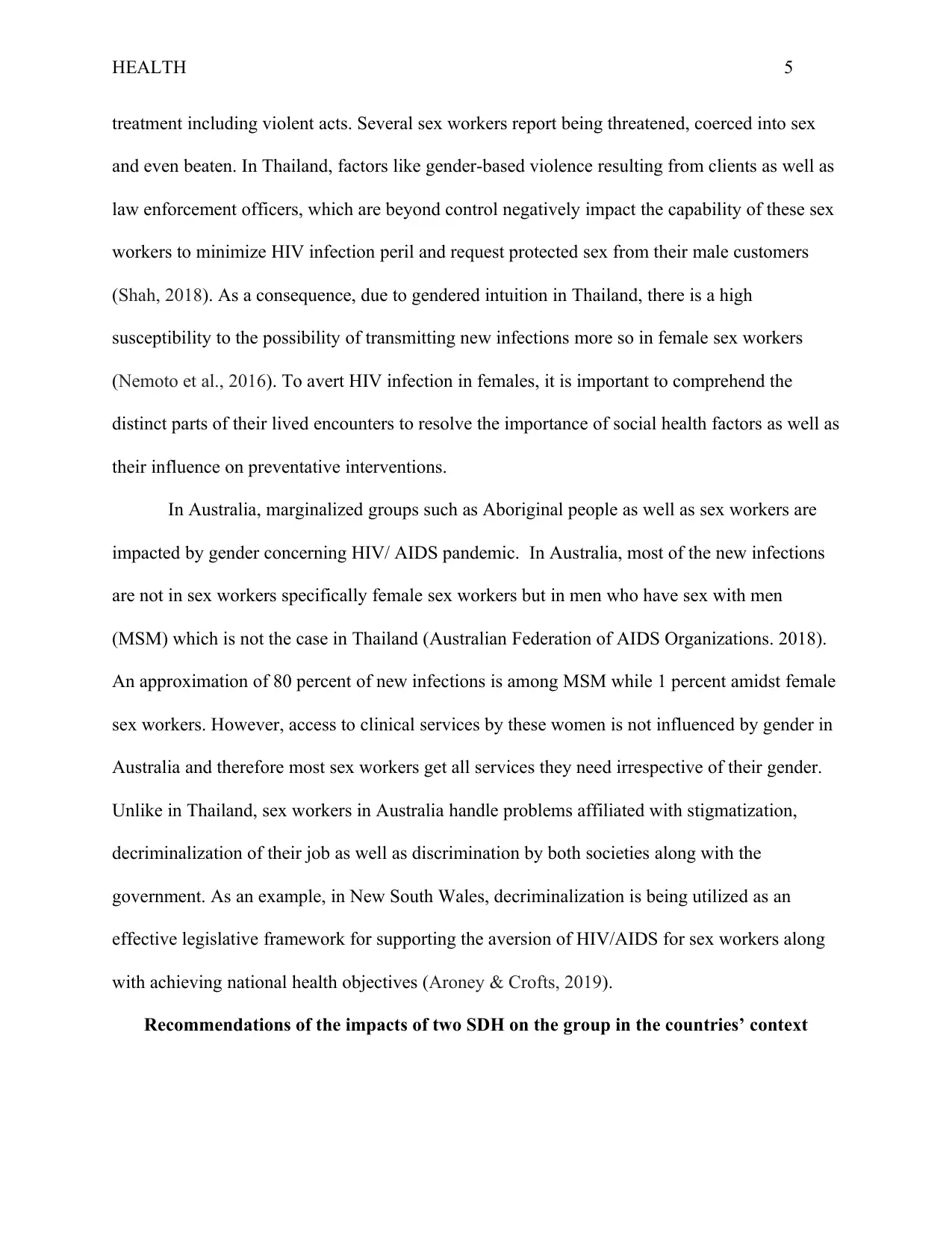
HEALTH 5
treatment including violent acts. Several sex workers report being threatened, coerced into sex
and even beaten. In Thailand, factors like gender-based violence resulting from clients as well as
law enforcement officers, which are beyond control negatively impact the capability of these sex
workers to minimize HIV infection peril and request protected sex from their male customers
(Shah, 2018). As a consequence, due to gendered intuition in Thailand, there is a high
susceptibility to the possibility of transmitting new infections more so in female sex workers
(Nemoto et al., 2016). To avert HIV infection in females, it is important to comprehend the
distinct parts of their lived encounters to resolve the importance of social health factors as well as
their influence on preventative interventions.
In Australia, marginalized groups such as Aboriginal people as well as sex workers are
impacted by gender concerning HIV/ AIDS pandemic. In Australia, most of the new infections
are not in sex workers specifically female sex workers but in men who have sex with men
(MSM) which is not the case in Thailand (Australian Federation of AIDS Organizations. 2018).
An approximation of 80 percent of new infections is among MSM while 1 percent amidst female
sex workers. However, access to clinical services by these women is not influenced by gender in
Australia and therefore most sex workers get all services they need irrespective of their gender.
Unlike in Thailand, sex workers in Australia handle problems affiliated with stigmatization,
decriminalization of their job as well as discrimination by both societies along with the
government. As an example, in New South Wales, decriminalization is being utilized as an
effective legislative framework for supporting the aversion of HIV/AIDS for sex workers along
with achieving national health objectives (Aroney & Crofts, 2019).
Recommendations of the impacts of two SDH on the group in the countries’ context
treatment including violent acts. Several sex workers report being threatened, coerced into sex
and even beaten. In Thailand, factors like gender-based violence resulting from clients as well as
law enforcement officers, which are beyond control negatively impact the capability of these sex
workers to minimize HIV infection peril and request protected sex from their male customers
(Shah, 2018). As a consequence, due to gendered intuition in Thailand, there is a high
susceptibility to the possibility of transmitting new infections more so in female sex workers
(Nemoto et al., 2016). To avert HIV infection in females, it is important to comprehend the
distinct parts of their lived encounters to resolve the importance of social health factors as well as
their influence on preventative interventions.
In Australia, marginalized groups such as Aboriginal people as well as sex workers are
impacted by gender concerning HIV/ AIDS pandemic. In Australia, most of the new infections
are not in sex workers specifically female sex workers but in men who have sex with men
(MSM) which is not the case in Thailand (Australian Federation of AIDS Organizations. 2018).
An approximation of 80 percent of new infections is among MSM while 1 percent amidst female
sex workers. However, access to clinical services by these women is not influenced by gender in
Australia and therefore most sex workers get all services they need irrespective of their gender.
Unlike in Thailand, sex workers in Australia handle problems affiliated with stigmatization,
decriminalization of their job as well as discrimination by both societies along with the
government. As an example, in New South Wales, decriminalization is being utilized as an
effective legislative framework for supporting the aversion of HIV/AIDS for sex workers along
with achieving national health objectives (Aroney & Crofts, 2019).
Recommendations of the impacts of two SDH on the group in the countries’ context
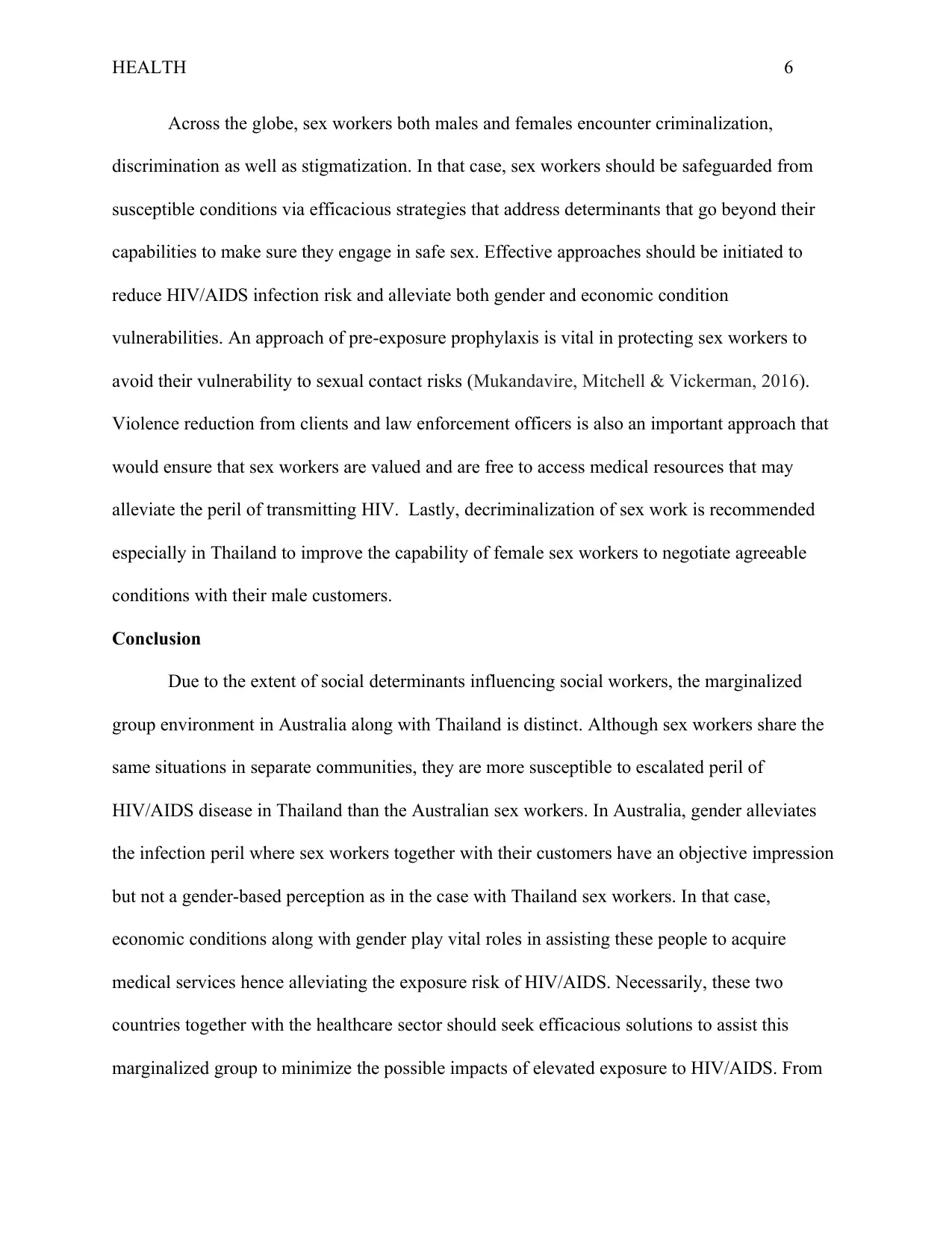
HEALTH 6
Across the globe, sex workers both males and females encounter criminalization,
discrimination as well as stigmatization. In that case, sex workers should be safeguarded from
susceptible conditions via efficacious strategies that address determinants that go beyond their
capabilities to make sure they engage in safe sex. Effective approaches should be initiated to
reduce HIV/AIDS infection risk and alleviate both gender and economic condition
vulnerabilities. An approach of pre-exposure prophylaxis is vital in protecting sex workers to
avoid their vulnerability to sexual contact risks (Mukandavire, Mitchell & Vickerman, 2016).
Violence reduction from clients and law enforcement officers is also an important approach that
would ensure that sex workers are valued and are free to access medical resources that may
alleviate the peril of transmitting HIV. Lastly, decriminalization of sex work is recommended
especially in Thailand to improve the capability of female sex workers to negotiate agreeable
conditions with their male customers.
Conclusion
Due to the extent of social determinants influencing social workers, the marginalized
group environment in Australia along with Thailand is distinct. Although sex workers share the
same situations in separate communities, they are more susceptible to escalated peril of
HIV/AIDS disease in Thailand than the Australian sex workers. In Australia, gender alleviates
the infection peril where sex workers together with their customers have an objective impression
but not a gender-based perception as in the case with Thailand sex workers. In that case,
economic conditions along with gender play vital roles in assisting these people to acquire
medical services hence alleviating the exposure risk of HIV/AIDS. Necessarily, these two
countries together with the healthcare sector should seek efficacious solutions to assist this
marginalized group to minimize the possible impacts of elevated exposure to HIV/AIDS. From
Across the globe, sex workers both males and females encounter criminalization,
discrimination as well as stigmatization. In that case, sex workers should be safeguarded from
susceptible conditions via efficacious strategies that address determinants that go beyond their
capabilities to make sure they engage in safe sex. Effective approaches should be initiated to
reduce HIV/AIDS infection risk and alleviate both gender and economic condition
vulnerabilities. An approach of pre-exposure prophylaxis is vital in protecting sex workers to
avoid their vulnerability to sexual contact risks (Mukandavire, Mitchell & Vickerman, 2016).
Violence reduction from clients and law enforcement officers is also an important approach that
would ensure that sex workers are valued and are free to access medical resources that may
alleviate the peril of transmitting HIV. Lastly, decriminalization of sex work is recommended
especially in Thailand to improve the capability of female sex workers to negotiate agreeable
conditions with their male customers.
Conclusion
Due to the extent of social determinants influencing social workers, the marginalized
group environment in Australia along with Thailand is distinct. Although sex workers share the
same situations in separate communities, they are more susceptible to escalated peril of
HIV/AIDS disease in Thailand than the Australian sex workers. In Australia, gender alleviates
the infection peril where sex workers together with their customers have an objective impression
but not a gender-based perception as in the case with Thailand sex workers. In that case,
economic conditions along with gender play vital roles in assisting these people to acquire
medical services hence alleviating the exposure risk of HIV/AIDS. Necessarily, these two
countries together with the healthcare sector should seek efficacious solutions to assist this
marginalized group to minimize the possible impacts of elevated exposure to HIV/AIDS. From
⊘ This is a preview!⊘
Do you want full access?
Subscribe today to unlock all pages.

Trusted by 1+ million students worldwide
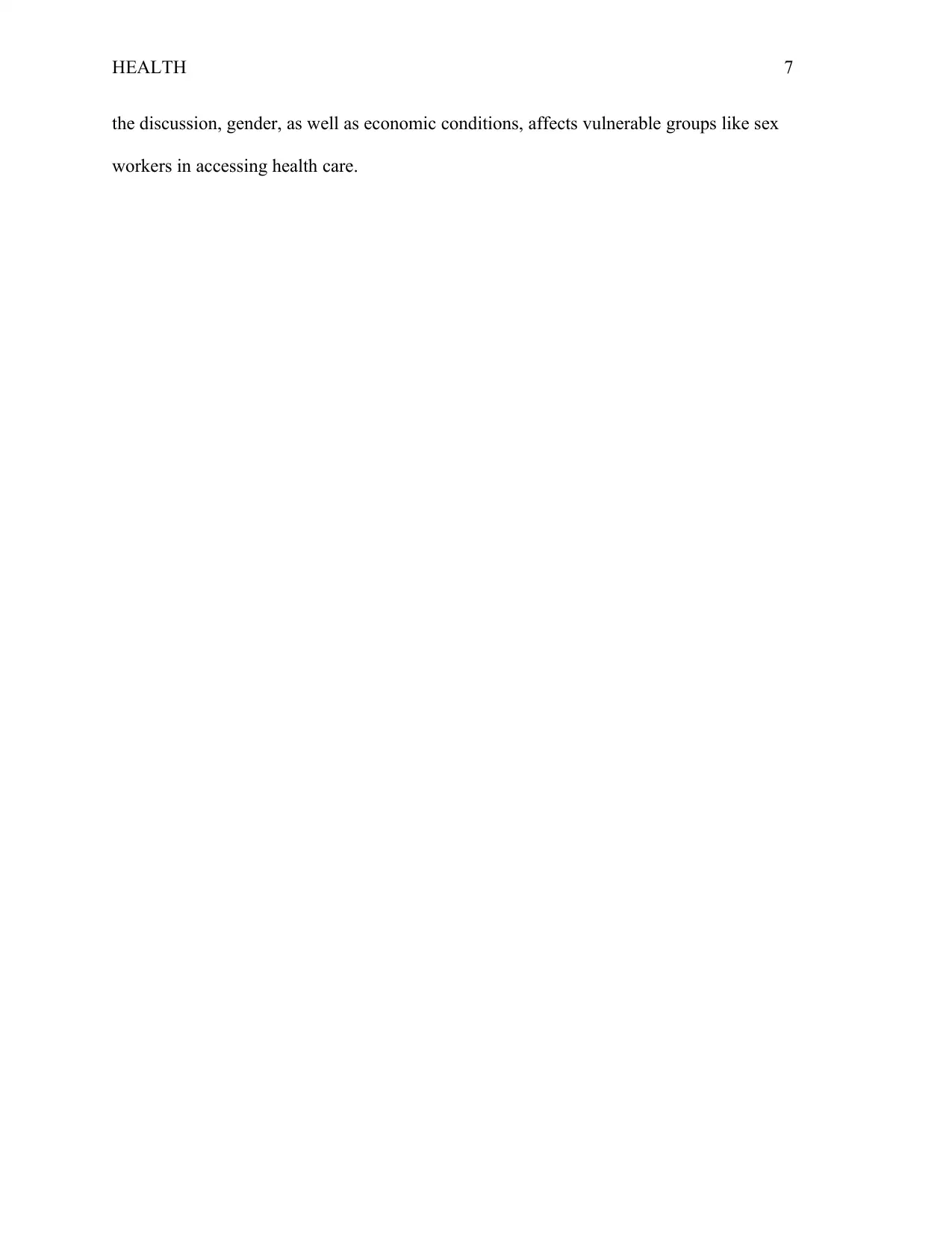
HEALTH 7
the discussion, gender, as well as economic conditions, affects vulnerable groups like sex
workers in accessing health care.
the discussion, gender, as well as economic conditions, affects vulnerable groups like sex
workers in accessing health care.
Paraphrase This Document
Need a fresh take? Get an instant paraphrase of this document with our AI Paraphraser
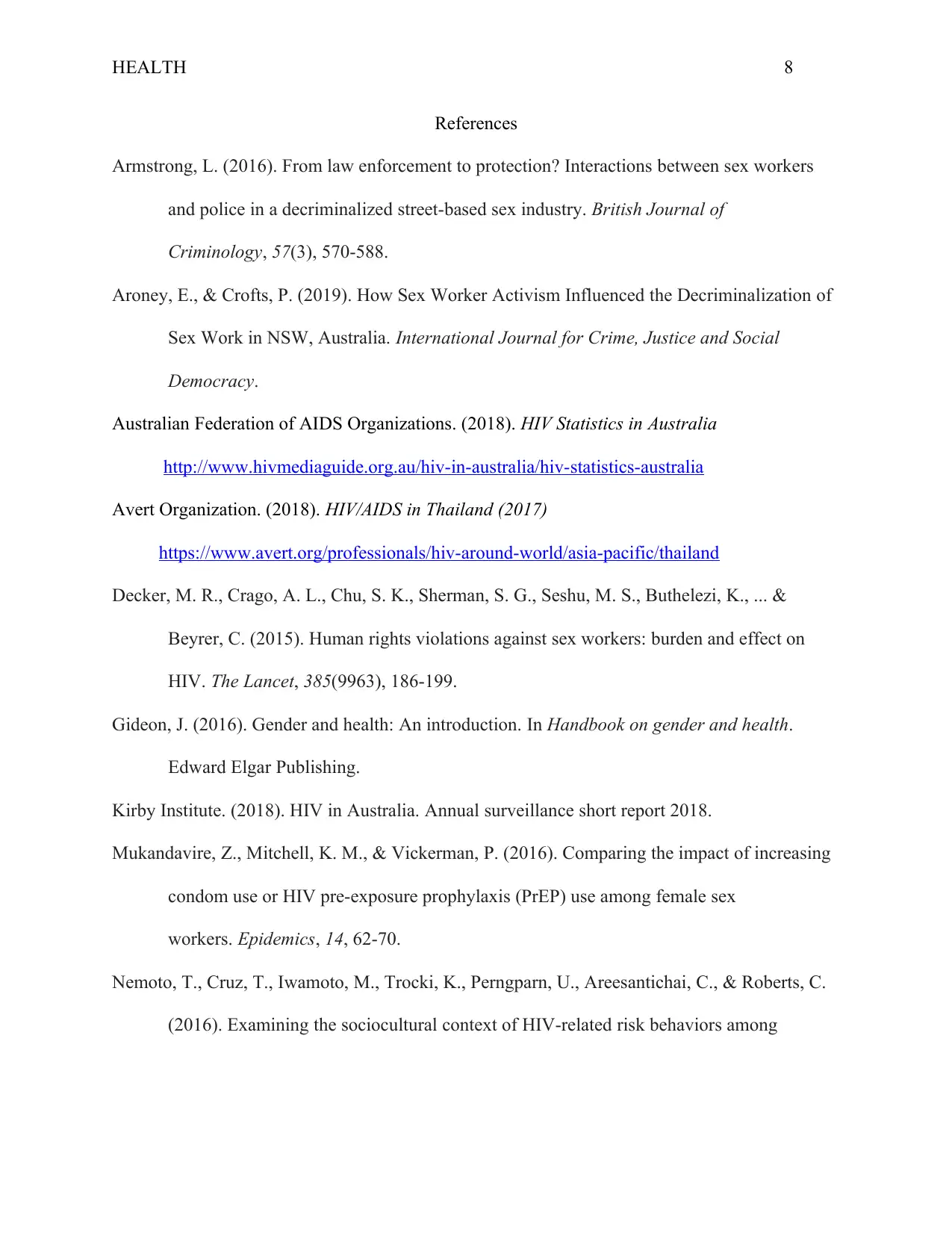
HEALTH 8
References
Armstrong, L. (2016). From law enforcement to protection? Interactions between sex workers
and police in a decriminalized street-based sex industry. British Journal of
Criminology, 57(3), 570-588.
Aroney, E., & Crofts, P. (2019). How Sex Worker Activism Influenced the Decriminalization of
Sex Work in NSW, Australia. International Journal for Crime, Justice and Social
Democracy.
Australian Federation of AIDS Organizations. (2018). HIV Statistics in Australia
http://www.hivmediaguide.org.au/hiv-in-australia/hiv-statistics-australia
Avert Organization. (2018). HIV/AIDS in Thailand (2017)
https://www.avert.org/professionals/hiv-around-world/asia-pacific/thailand
Decker, M. R., Crago, A. L., Chu, S. K., Sherman, S. G., Seshu, M. S., Buthelezi, K., ... &
Beyrer, C. (2015). Human rights violations against sex workers: burden and effect on
HIV. The Lancet, 385(9963), 186-199.
Gideon, J. (2016). Gender and health: An introduction. In Handbook on gender and health.
Edward Elgar Publishing.
Kirby Institute. (2018). HIV in Australia. Annual surveillance short report 2018.
Mukandavire, Z., Mitchell, K. M., & Vickerman, P. (2016). Comparing the impact of increasing
condom use or HIV pre-exposure prophylaxis (PrEP) use among female sex
workers. Epidemics, 14, 62-70.
Nemoto, T., Cruz, T., Iwamoto, M., Trocki, K., Perngparn, U., Areesantichai, C., & Roberts, C.
(2016). Examining the sociocultural context of HIV-related risk behaviors among
References
Armstrong, L. (2016). From law enforcement to protection? Interactions between sex workers
and police in a decriminalized street-based sex industry. British Journal of
Criminology, 57(3), 570-588.
Aroney, E., & Crofts, P. (2019). How Sex Worker Activism Influenced the Decriminalization of
Sex Work in NSW, Australia. International Journal for Crime, Justice and Social
Democracy.
Australian Federation of AIDS Organizations. (2018). HIV Statistics in Australia
http://www.hivmediaguide.org.au/hiv-in-australia/hiv-statistics-australia
Avert Organization. (2018). HIV/AIDS in Thailand (2017)
https://www.avert.org/professionals/hiv-around-world/asia-pacific/thailand
Decker, M. R., Crago, A. L., Chu, S. K., Sherman, S. G., Seshu, M. S., Buthelezi, K., ... &
Beyrer, C. (2015). Human rights violations against sex workers: burden and effect on
HIV. The Lancet, 385(9963), 186-199.
Gideon, J. (2016). Gender and health: An introduction. In Handbook on gender and health.
Edward Elgar Publishing.
Kirby Institute. (2018). HIV in Australia. Annual surveillance short report 2018.
Mukandavire, Z., Mitchell, K. M., & Vickerman, P. (2016). Comparing the impact of increasing
condom use or HIV pre-exposure prophylaxis (PrEP) use among female sex
workers. Epidemics, 14, 62-70.
Nemoto, T., Cruz, T., Iwamoto, M., Trocki, K., Perngparn, U., Areesantichai, C., & Roberts, C.
(2016). Examining the sociocultural context of HIV-related risk behaviors among
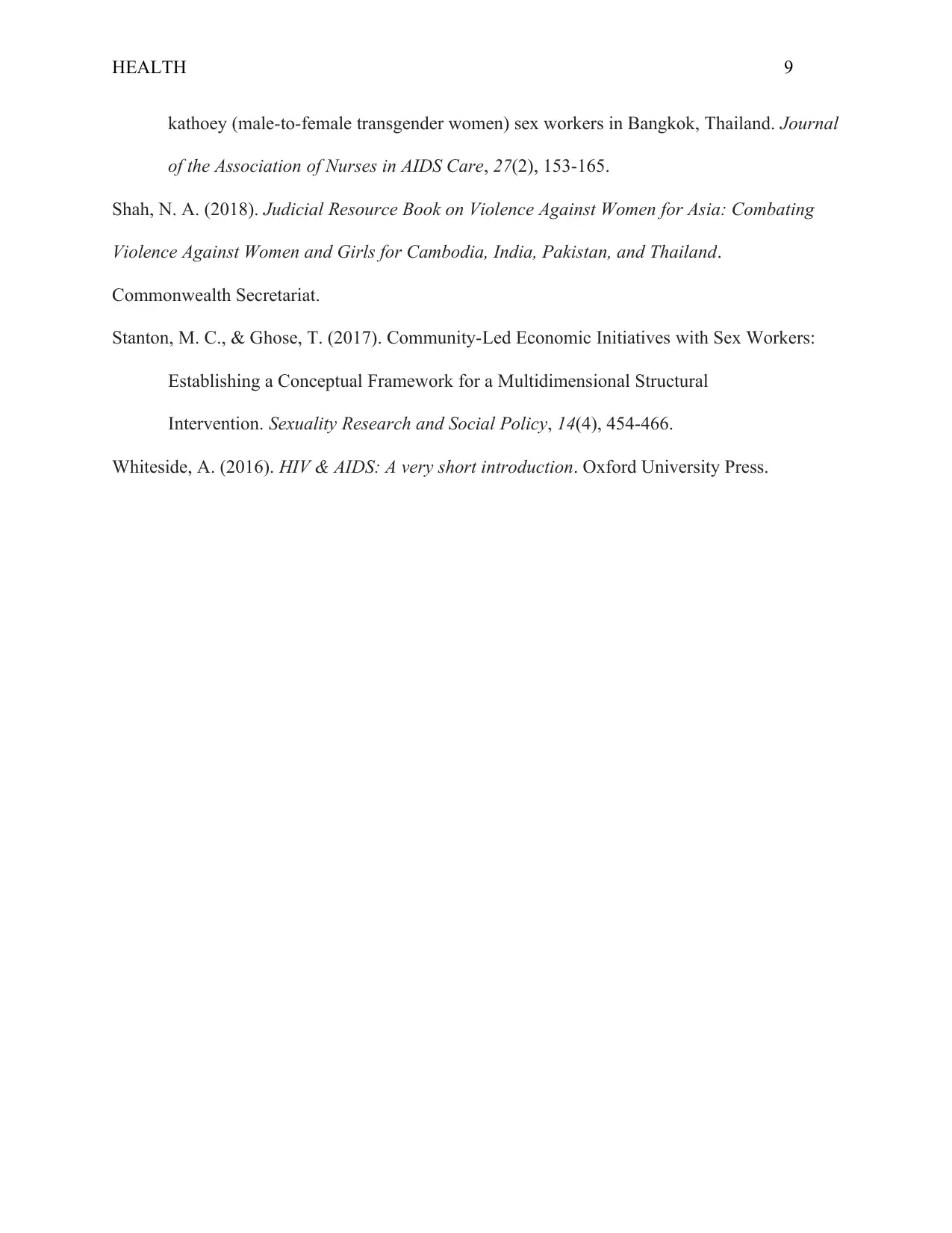
HEALTH 9
kathoey (male-to-female transgender women) sex workers in Bangkok, Thailand. Journal
of the Association of Nurses in AIDS Care, 27(2), 153-165.
Shah, N. A. (2018). Judicial Resource Book on Violence Against Women for Asia: Combating
Violence Against Women and Girls for Cambodia, India, Pakistan, and Thailand.
Commonwealth Secretariat.
Stanton, M. C., & Ghose, T. (2017). Community-Led Economic Initiatives with Sex Workers:
Establishing a Conceptual Framework for a Multidimensional Structural
Intervention. Sexuality Research and Social Policy, 14(4), 454-466.
Whiteside, A. (2016). HIV & AIDS: A very short introduction. Oxford University Press.
kathoey (male-to-female transgender women) sex workers in Bangkok, Thailand. Journal
of the Association of Nurses in AIDS Care, 27(2), 153-165.
Shah, N. A. (2018). Judicial Resource Book on Violence Against Women for Asia: Combating
Violence Against Women and Girls for Cambodia, India, Pakistan, and Thailand.
Commonwealth Secretariat.
Stanton, M. C., & Ghose, T. (2017). Community-Led Economic Initiatives with Sex Workers:
Establishing a Conceptual Framework for a Multidimensional Structural
Intervention. Sexuality Research and Social Policy, 14(4), 454-466.
Whiteside, A. (2016). HIV & AIDS: A very short introduction. Oxford University Press.
⊘ This is a preview!⊘
Do you want full access?
Subscribe today to unlock all pages.

Trusted by 1+ million students worldwide
1 out of 9
Related Documents
Your All-in-One AI-Powered Toolkit for Academic Success.
+13062052269
info@desklib.com
Available 24*7 on WhatsApp / Email
![[object Object]](/_next/static/media/star-bottom.7253800d.svg)
Unlock your academic potential
Copyright © 2020–2025 A2Z Services. All Rights Reserved. Developed and managed by ZUCOL.





